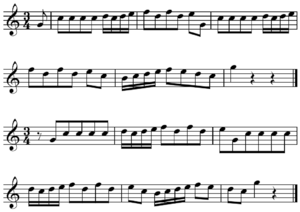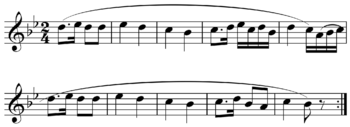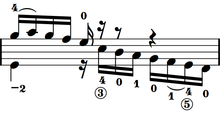Musical phrasing
Musical phrasing is the way a musician shapes a sequence of notes in a passage of music to allow expression, much like when speaking English a phrase may be written identically but may be spoken differently, and is named for the interpretation of small units of time known as phrases (half of a period). A musician accomplishes this by interpreting the music—from memory or sheet music—by altering tone, tempo, dynamics, articulation, inflection, and other characteristics. Phrasing can emphasise a concept in the music or a message in the lyrics, or it can digress from the composer's intention, aspects of which are commonly indicated in musical notation called phrase marks or phrase markings. For example, accelerating the tempo or prolonging a note may add tension.
A phrase is a substantial musical thought, which ends with a musical punctuation called a cadence. Phrases are created in music through an interaction of melody, harmony, and rhythm.[3]

Giuseppe Cambini—a composer, violinist, and music teacher of the Classical period—had this to say about bowed string instruments, specifically violin, phrasing:
The bow can express the affections of the soul: but besides there being no signs that indicate them, such signs, even were one to invent them, would become so numerous that the music, already too full of indications, would become a formless mass to the eyes, almost impossible to decipher. I should consider myself fortunate if I could only get a student to hear, through a small number of examples, the difference between bad and mediocre, mediocre and good, and good and excellent, in the diversity of expressions that one may give to the same passage.[4]
— "Nouvelle Méthode théorique et pratique pour le violon". Paris, Naderman (c. 1803)
Intuitive and analytical phrasing
"There are two schools of thought on phrasing," says flutist Nancy Toff: "one more intuitive, the other more analytical. The intuitive school uses a verbal model, equating the function of phrasing with that of punctuation in language. Thus, said Chopin to a student, 'He who phrases incorrectly is like a man who does not understand the language he speaks.'"[5]
Problems linked with an analytical approach to phrasing occur particularly when the analytical approach is based only on the search for objective information, or (as is often the case) only concerned with the score:
The reliance on the score for information about temporal structures reflects a more profound analytical difficulty. Structural information gleaned from the score is visually apprehended and as such is predisposed to visualist models of structure. These models are premised on symmetry and balance and on a timeless notion of "objective" structure. [...] Temporal and aurally-apprehended structures are denied reality because they cannot be said to "exist" in the way that spatial and visually apprehended structures do. [...] Musical investigations exhibit the Western prejudice toward visualism in the dependence on visual symmetry and balance. Information about structure from listening experience is suspect because it is considered "subjective" and is opposed to "objective" information from the score.
— F. Joseph Smith[6]
Elision or reinterpretation
In the analysis of 18th- and 19th-century Western music, an elision, overlap, or rather reinterpretation (Umdeutung), is the perception, after the fact, of a (metrically weak) cadential chord at the end of one phrase as the (metrically strong) initial chord of the next phrase. Two phrases may overlap, making the beginning and ending of both happen at the same moment in time, or both phrases and hypermeasures may overlap, making the last bar in the first hypermeasure and the first in the second. Charles Burkhart uses overlap and reinterpretation to distinguish between the overlap of phrases and of both phrase and measure-group, respectively.[7][8]
See also
References
- Newman, William S. (1995). Beethoven on Beethoven: Playing His Piano Music His Way, p.170-71. ISBN 0-393-30719-0.
- White, John D. (1976). The Analysis of Music, p. 44. ISBN 0-13-033233-X.
- Benward, Bruce & Saker, Marilyn (2003). Music: In Theory and Practice, Vol. I, p.89. Seventh Edition. McGraw-Hill. ISBN 978-0-07-294262-0.
- "Nouvelle Méthode théorique et pratique pour le violon" by Giuseppe Cambini (ref)
- Toff, Nancy (1996). The Flute Book: A Complete Guide for Students and Performers (Second ed.). p. 150. ISBN 978-0-19-510502-5.
- Smith, F. Joseph (1989). Understanding the Musical Experience, p.121-124. ISBN 978-2-88124-204-5.
- Stein, Deborah (2005). Engaging Music: Essays in Music Analysis, p.328, 330. New York: Oxford University Press. ISBN 0-19-517010-5.
- Burkhart, Charles. "The Phrase Rhythm of Chopin's A-flat Major Mazurka, Op. 59, No. 2", p.10, 11n14. Cited in Stein (2005).
Further reading
- Liebling, Emil, ed. (1908). "Phrasing". The American History and Encyclopedia of Music. 1. New York: Irving Squire. pp. 267–82.
- "The Art of Phrasing". Dwight's Journal of Music. Boston. 37 (21). 19 January 1878.
- Curry, Samuel Silas. "Phrasing". Lessons in Vocal Expression, Course I: Processes of Thinking in the Modulation of Voice. Boston: The Expression Company. pp. 73–80.
External links

| Wikimedia Commons has media related to Musical phrasing. |

